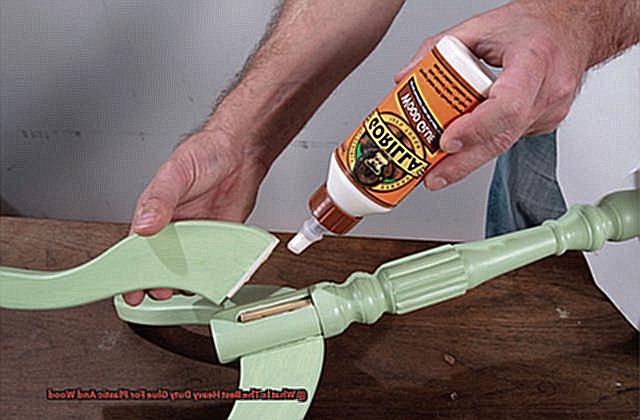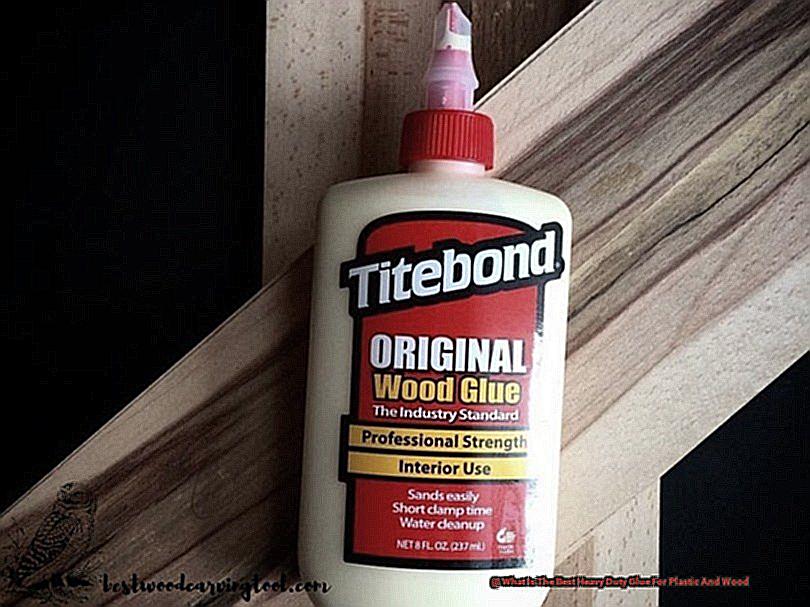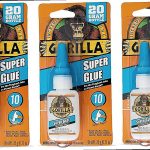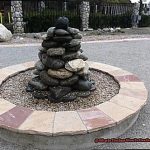Are you tired of your woodwork and plastic projects falling apart at the seams?
In today’s blog post, we’re about to unveil the ultimate solution to all your bonding needs—the holy grail of heavy-duty glues for plastic and wood.
Whether you’re a DIY enthusiast or a seasoned professional craftsman, finding the right adhesive can be a game-changer. Imagine this: a glue that effortlessly withstands Herculean loads, resists even the most stubborn moisture, and creates an unbreakable bond that stands the test of time.
This magical adhesive combines the strength and durability required for heavy-duty tasks, while also offering unparalleled versatility and ease of use. Bid farewell to frustrating adhesives that disappoint, and say hello to a true revolution in the world of bonding.
Brace yourself to discover the perfect blend of unwavering reliability and jaw-dropping performance that will transform your projects into masterpieces that defy gravity.
What is Heavy Duty Glue?
Contents
- 1 What is Heavy Duty Glue?
- 2 Benefits of Using Heavy Duty Glue for Plastic and Wood
- 3 Types of Heavy Duty Glues for Plastic and Wood
- 3.1 Epoxy Glue – The Unyielding Adhesive:
- 3.2 Epoxy glue is known for its versatility and ability to bond various types of plastics and woods. It works well on smooth or porous surfaces, making it suitable for a wide range of applications. Whether you’re repairing a broken plastic chair or building a wooden cabinet, epoxy glue will provide a reliable and long-lasting bond.
- 3.3 Polyurethane Adhesive – The Flexible Warrior:
- 3.4 If you’re looking for a glue that can handle both indoor and outdoor applications, polyurethane adhesive is your go-to choice. Known for its flexibility and water resistance, this adhesive is ideal for woodworking projects or bonding plastic materials like PVC. Its ability to withstand high impact forces makes it an excellent option for heavy-duty tasks.
- 3.5 Cyanoacrylate Glue – The Speedy Fixer:
- 3.6 Cyanoacrylate glue forms an instant bond that can withstand moderate stress. It is commonly used for small-scale projects or quick fixes where precision and speed are essential. Whether you’re repairing a broken plastic toy or bonding wooden trim, cyanoacrylate glue will provide a reliable and efficient solution.
- 3.7 Silicone Adhesive – The Stretchy Savior:
- 4 Epoxy Resin: The Most Popular Choice
- 5 Polyurethane Adhesive: An Alternative Option
- 6 Super Glue: A Quick Setting Option
- 7 Considerations When Choosing a Heavy Duty Glue
- 8 Preparing the Surfaces Before Applying the Glue
When you need to bond materials like plastic and wood, regular glue just won’t cut it. You need something stronger, something that can withstand heavy loads, extreme temperatures, and harsh environmental conditions. That’s where heavy duty glue comes in. Also known as industrial-strength adhesive, heavy duty glue is specifically formulated to provide strong and long-lasting bonds for demanding applications.
Heavy duty glues are the go-to choice in industries like construction, manufacturing, woodworking, and automotive, where reliable bonds are essential. These glues are known for their high bond strength, resistance to moisture, chemicals, and UV rays, as well as their ability to withstand vibrations and impacts.
There are different types of heavy duty glues available to suit different applications. Here are a few examples:
- Epoxy resin: This popular choice for bonding plastic and wood consists of a resin and a hardener that are mixed together. Epoxy resin offers high bond strength, excellent resistance to moisture, heat, and chemicals, and the ability to fill gaps and create a seamless bond.
- Polyurethane adhesive: Another option for bonding plastic and wood, polyurethane adhesive provides strong bond strength, flexibility, and resistance to water and heat. It’s commonly used in construction and woodworking applications.
- Cyanoacrylate (super glue): Known for its quick setting time and strong bond, super glue can also be used for bonding plastic and wood. However, it may not be the best choice for larger or load-bearing surfaces.
When using heavy duty glue for plastic and wood, it’s important to consider factors such as the specific materials being bonded, desired bond strength, application method, and project requirements. Some heavy duty glues require surface preparation before application, while others can be used directly on the materials.
Before applying any heavy duty glue, it’s always a good idea to test it on a small, inconspicuous area to ensure compatibility and optimal bonding. Following the manufacturer’s instructions for proper usage and curing times is essential for achieving the best results.
Benefits of Using Heavy Duty Glue for Plastic and Wood
This adhesive offers a range of benefits that make it a must-have in your toolbox.
Firstly, let’s talk about strength. Heavy duty glue is designed to create a bond that can withstand even the toughest challenges. Whether you’re fixing a broken plastic item or constructing a wooden masterpiece, this glue provides the muscle needed to keep things together for the long haul.

But it doesn’t stop there. Heavy duty glue is incredibly versatile, capable of bonding various types of plastics like PVC, acrylic, and polycarbonate, as well as different types of wood such as hardwood, softwood, and plywood. No matter what materials you’re working with, heavy duty glue has got you covered.
And let’s not forget about Mother Nature’s wrath. Heavy duty glue is formulated to resist moisture, heat, cold, and even UV radiation. So whether you’re building outdoor furniture or repairing plastic items that will be exposed to the elements, rest assured that this glue will stand strong against weather conditions.
Time is precious, my friends, and heavy duty glue understands that. Say goodbye to drilling holes and waiting for screws to tighten. With this adhesive in your hands, simply apply it to the surfaces you want to join and hold them together until the bond sets. It’s quick, easy, and saves you valuable construction or repair time.
Now let’s talk about aesthetics. Heavy duty glue creates a seamless bond between plastic and wood surfaces, leaving no visible marks or damage. This means your projects will have a clean and professional finish that will impress even the toughest critics.
Last but not least, heavy duty glue is a cost-effective solution. No need to break the bank on expensive tools or equipment. This glue is affordable and can be used in small quantities, reducing waste and saving you money in the long run. So whether you’re a DIY enthusiast or a seasoned professional, heavy duty glue is a superhero adhesive that won’t burn a hole in your wallet.
Types of Heavy Duty Glues for Plastic and Wood
When it comes to bonding plastic and wood, you need a glue that can withstand the test of time and hold everything together. Luckily, there are several heavy-duty glues specifically designed for this purpose. In this article, we will explore four powerful glues that can tackle any plastic-wood bonding project.
Epoxy Glue – The Unyielding Adhesive:
Epoxy glue is a true heavyweight in the world of adhesives. Made up of two components, resin and hardener, it forms an incredibly strong bond when mixed together. This mighty adhesive is perfect for repairing furniture or joining plastic and wooden surfaces. Not only does epoxy glue provide exceptional durability, but it also resists moisture, chemicals, and temperature changes.
Epoxy glue is known for its versatility and ability to bond various types of plastics and woods. It works well on smooth or porous surfaces, making it suitable for a wide range of applications. Whether you’re repairing a broken plastic chair or building a wooden cabinet, epoxy glue will provide a reliable and long-lasting bond.

Polyurethane Adhesive – The Flexible Warrior:
If you’re looking for a glue that can handle both indoor and outdoor applications, polyurethane adhesive is your go-to choice. Known for its flexibility and water resistance, this adhesive is ideal for woodworking projects or bonding plastic materials like PVC. Its ability to withstand high impact forces makes it an excellent option for heavy-duty tasks.
Polyurethane adhesive forms a strong bond that can handle stress, expansion, and contraction without weakening. This makes it suitable for applications where the bonded materials may experience movement or temperature fluctuations. Whether you’re constructing outdoor furniture or bonding plastic pipes, polyurethane adhesive will provide the strength and resilience needed to withstand the elements.
Cyanoacrylate Glue – The Speedy Fixer:
When time is of the essence, cyanoacrylate glue, also known as super glue, comes to the rescue. With its fast-drying properties and formidable bond strength, this adhesive is perfect for bonding smooth plastic and wood surfaces. However, keep in mind that it may not be as suitable for porous or uneven surfaces.
Cyanoacrylate glue forms an instant bond that can withstand moderate stress. It is commonly used for small-scale projects or quick fixes where precision and speed are essential. Whether you’re repairing a broken plastic toy or bonding wooden trim, cyanoacrylate glue will provide a reliable and efficient solution.
Silicone Adhesive – The Stretchy Savior:
Sometimes, flexibility is crucial to ensure a successful bond between plastic and wood with different expansion rates. Silicone adhesive offers just that. It provides a strong yet flexible bond, making it perfect for applications where movement or stress may occur. Whether it’s joining plastic panels or bonding wooden parts, silicone adhesive has got you covered.
Epoxy Resin: The Most Popular Choice
Epoxy resin reigns supreme as the most popular choice for heavy-duty applications like bonding plastic and wood. Its popularity is a testament to the multitude of advantages it offers, making it unrivaled in strength, durability, versatility, and cost-effectiveness.
One of the key advantages of epoxy resin lies in its excellent adhesive properties. It has the ability to bond different materials together, making it perfect for joining plastic and wood. Whether you’re repairing broken wooden furniture, fixing plastic parts, or creating durable woodworking projects, epoxy resin has got you covered.
Furthermore, epoxy resin’s resistance to moisture, chemicals, and heat makes it suitable for both indoor and outdoor use. Its long-lasting bond can withstand heavy loads and stress, ensuring that your projects remain intact for years to come.
The versatility of epoxy resin is another reason for its popularity. It is available in various forms such as liquid epoxy, epoxy putty, or epoxy paste, offering flexibility in application methods. Whether you need to fill gaps or create a smooth finish, epoxy resin can adapt to your requirements.
In terms of cost-effectiveness, epoxy resin proves to be a wise investment. Its strength and durability mean that you won’t need to constantly repair or replace your bonded materials. A little goes a long way with epoxy resin, making it a cost-effective choice for heavy-duty applications.
However, it is important to note that while epoxy resin excels in many areas, it may not be suitable for all applications. Factors such as temperature resistance, flexibility requirements, or specific material compatibility should be taken into consideration when choosing the best glue for a particular project.
Polyurethane Adhesive: An Alternative Option
In the realm of heavy-duty applications, finding the perfect adhesive to bond plastic and wood surfaces can seem like an impossible task. While epoxy resin has long been the go-to choice, there is a lesser-known but equally impressive adhesive that deserves consideration – polyurethane adhesive. This article delves into the advantages of using polyurethane adhesive, why it should be a top contender for your bonding needs, and how to achieve optimal results.
Advantage 1: Excellent Adhesion to a Variety of Surfaces
Polyurethane adhesive boasts remarkable adhesion capabilities, extending its reach beyond plastic and wood. It forms reliable bonds with polyethylene, polypropylene, PVC, ABS, acrylics, and more. This versatility allows for a wide range of applications where different materials need to be seamlessly joined together.
Advantage 2: Strength and Durability
Renowned for its unyielding strength and durability, polyurethane adhesive stands up against high loads, impacts, and vibrations. It is the epitome of reliability in heavy-duty applications. Whether you’re constructing structures or crafting furniture, polyurethane adhesive ensures longevity and steadfastness.
Advantage 3: Resistance to Moisture and Temperature Variations
Once cured, polyurethane adhesive forms a waterproof bond that scoffs at water, humidity, and extreme temperatures. It scoffs so hard, in fact, that it is perfect for outdoor use or applications where bonded materials may experience fluctuating conditions. Rain or shine, hot or cold – polyurethane adhesive takes it all in stride.
Advantage 4: Flexibility for Dynamic Applications
The flexibility of polyurethane adhesive is truly a marvel. It absorbs vibrations and movements without compromising its bond strength. Picture this: slight movements or vibrations occur over time. Instead of weakening the bond like other adhesives might, polyurethane adhesive stands tall, unfazed and unyielding.
Super Glue: A Quick Setting Option
When it comes to bonding plastic and wood, you need an adhesive that is not only strong but also quick-setting. That’s where super glue, also known as cyanoacrylate adhesive, comes into play. This clear, liquid adhesive is a game-changer for all your bonding needs.
So, why is super glue the go-to option for quickly bonding plastic and wood? Let’s break it down:
- Lightning-fast Bonding: Super glue lives up to its name by forming a strong bond within seconds of application. Say goodbye to waiting around for hours for your project to dry. With super glue, you can get back to business in no time.
- Moisture Activated: The secret behind super glue’s rapid setting power lies in its reaction with moisture. Whether it’s the humidity in the air or the moisture on the surfaces you’re bonding, super glue reacts quickly and hardens to create a firm grip.
- Versatile Viscosity: Super glue offers various viscosities to suit different applications. Thin viscosity is perfect for bonding small parts or tight spaces, while medium viscosity strikes a balance between strength and flexibility. And if you need something that stays put without running or dripping, go for the gel-like super glue.
- Prep is Key: To maximize the effectiveness of super glue on plastic and wood, make sure to clean the surfaces thoroughly. Dirt, dust, or grease can interfere with the adhesive’s bonding strength. A little prep goes a long way.
- Test It Out: While super glue works wonders on most plastics and woods, it’s always a good idea to do a test run before going all-in. Some plastics with low surface energy or certain types of wood may require specialized adhesives for optimal results.
Remember, less is more when it comes to super glue. Use it sparingly as a little goes a long way. And please, follow the instructions provided by the manufacturer to ensure safe and proper usage.
Considerations When Choosing a Heavy Duty Glue
Choosing the right heavy-duty glue for your plastic and wood projects requires careful consideration. The adhesive you select can determine the strength and durability of your work, so it’s essential to make an informed decision. Let’s explore some crucial factors that should guide you in finding the perfect glue for your needs.
Firstly, think about the type of materials you’ll be bonding. Not all glues are suitable for both plastic and wood, so it’s crucial to find one specifically designed for these materials. Look for glues labeled as suitable for both plastic and wood or those with specific instructions for bonding these materials.
Strength and durability are paramount when it comes to heavy-duty glues. Look for options with high bond strength and a reputation for long-lasting effectiveness. Reading reviews and customer feedback can provide valuable insights into a glue’s performance.
Consider the drying time of the glue as well. Some glues require longer drying times, which may not be convenient if you need to handle or move your project quickly. Conversely, quick-drying formulas can expedite project completion. Evaluate your timeline and requirements to choose a glue with an appropriate drying time.
Next, consider the application method that suits your project best. Glues come in various forms like liquid, gel, or adhesive tapes. Liquid glues offer versatility and can be applied using brushes or applicator tips, while adhesive tapes provide convenience and ease of use. Select a glue with an application method that aligns with your project’s specific needs.
Compatibility is another vital factor to keep in mind. If you plan on using other materials alongside plastic and wood, such as metal or glass, ensure that the glue you choose is compatible with those materials as well. Some glues may not adhere well to certain surfaces, so check compatibility before proceeding.
Lastly, prioritize safety precautions and health hazards associated with the glue. Some heavy-duty glues contain strong chemicals that can be harmful if inhaled or come into contact with the skin. Always read and follow the manufacturer’s instructions regarding safety precautions, ventilation requirements, and proper handling of the glue.
Also Read: What is the best glue to stick fabric to wood?
Preparing the Surfaces Before Applying the Glue
When it comes to joining plastic and wood, the secret to unbreakable bonds lies in proper surface preparation before applying glue. In this comprehensive guide, we will walk you through the essential steps to prepare surfaces effectively, ensuring a long-lasting and robust bond. By following these instructions, you will unlock the full potential of your adhesive and create projects that withstand the test of time.
Step 1: The Power of Purity – Cleaning the Surfaces
Embark on your bonding journey by meticulously cleaning both the plastic and wood surfaces. Employ the dynamic duo of a mild detergent and warm water to banish any lurking dirt, dust, or grease. These sneaky culprits can sabotage adhesive performance. Rinse with care, allowing the surfaces to bask in the glory of complete dryness before advancing.
Step 2: The Art of Texture – Sanding the Surfaces
Embrace the transformative power of sandpaper with a medium grit to unlock the beauty of a better bonding surface. With each gentle stroke, you infuse both plastic and wood with a rough texture that seduces adhesive penetration and grip. Let uniformity be your mantra as you banish loose particles, leaving behind a textured masterpiece.
Step 3: Priming for Greatness – Applying Primer (if necessary)
Enter the realm of adhesive greatness by harnessing the almighty primer. This champion can elevate bonding capabilities, especially when conquering challenging plastics or woods. Unleash a thin coat of primer upon both surfaces, granting it the sacred rite of drying according to its manufacturer’s decree. Only then shall you proceed with glue application, knowing that primed perfection awaits.
Step 4: Taming Smooth Plastic – Roughening the Plastic Surface (if needed)
Smooth or glossy plastic surfaces may be formidable foes to adhesive conquest. Fear not. Unleash your weapon of choice: fine-grit sandpaper or a deft touch with a sharp blade. With calculated finesse, roughen the plastic surface, granting it the grip it craves.
Beware the line between sufficiency and excess, for too much roughening may mar its delicate beauty.
Step 5: Stripping Barriers – Removing Existing Coatings
Prepare to vanquish the foes that are varnish or paint coatings, standing as barriers to proper bonding. Equip yourself with sanding prowess, scraping tenacity, or the might of paint strippers. Engage in a dance with determination to eradicate these obstacles completely. Only then shall your adhesive reign supreme.






